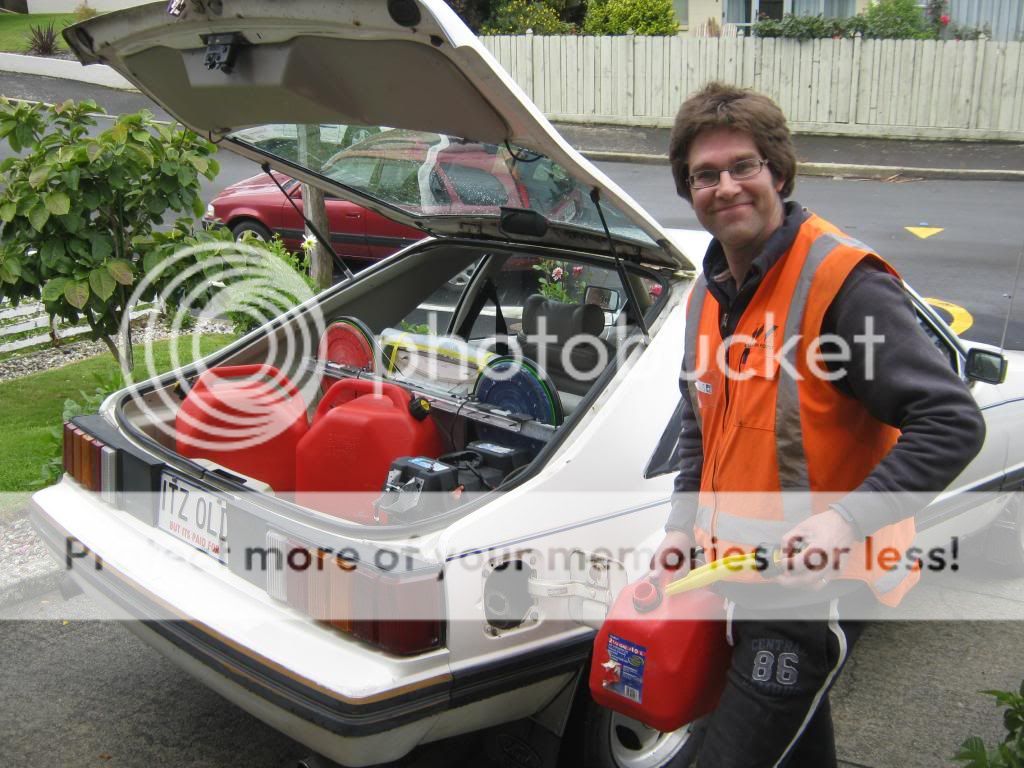Jakes66snake":nv7cdm30 said:
What do you exspect to see HP wise? Or I should ask, what kind of rpm and torque curve do plan to see?
I expect 140 hp with three 32/36's, stock 256 cam, knock sensor , two cats and water and methanol injection. Hopefully, stock flywheel torque will go up from 156 lb-ft to about 210 lb-ft.
I'll probably get 165, but I'm not sure what will happen with tuning it for reduced detonation. On the Schjeldahl Bro's website
http://www.falcon6handbook.com/compcalculator.asp, I should get a 50% boost on the basis of compression, but that doesn't allow for detonation tuning.
The arithmetic compression improvement is whopping 50%, which I think will yield an approximate 25% power improvement. The elimination of one point of 1-bbl fuel delivery and the application of a kind of semi independent runner induction improves the flow efficiency from a 40% air flow drop from an ideal 1.65" intake valve to just 15%, a flow increase without porting from the sucky 105 cfm to 127 cfm, or 22%. The same as an EO head with C1 head flow porting and tiny intake valves. There is also an ignition or lean misfire improvement from the out cylinders now getting enough fuel to eliminate over enriching to full fuel mixture, a common i6 ignition and fuel handicap. So i'll get close to the 22:1 air fuel ratio on part throttle that EFI cars regularly give.
With at least 50% from compression, about 22% from intake optimization, and then probably a 25% drop in power by up to 50% of anti detonation injection verses peak fuel flow. (ADI at that stratospheric ratio doesn't raise power as the engine is very close to detonation, just improves part throttle economy).
Based on 87 or 92 hp depending on what you believe for a stock 81 3.3.
A few really important notes:-
1. The 94.5 hp is the factory B code default rating, a figure without the fan clutch engaged, and it varied depending on trans, destination Fox Chassis, and either years from 1978 to 1983, it had a T code 85 hp, or X code 91 hp rating.
2. A car that wouldn't pass 31 mpg Highway ,
3. not top the 100 mph mark,
4. at best, do only a 19.0 sec 1320 foot time at the Standing 1/4.
5. The factory 4 speed stick-shift B code for 1981 was certainly never a 2 bbl Holley Weber or VV Motorcraft as the article claims....,it was always just a 1 bbl 1946C Holley Motorcraft carb,
6. a one year only 1352 case T5 but with a Four speed T4 Borg Warner IN THIS T-Top Mercury Capri with a 2.47 axle ratio.
7. It is not a 3.08 axle 0.81 overdrive 2.49:1 top SROD 4- speed as claimed in this
Motor Trend March 1981 magazine repitch. The two Tremc T170's and T4 BW were avaliable at the ame time, and had the same effective overall gear ratios from 1 st to 4th.
Based on all that baseline info, what I expect is that I should end up with 140 hp, or about as much as a stock timed 3.3 with a Classic Inlines head on 8.5:1 compression and one 227 cfm at 1.5" Hg 32/36 carb.
At the moment, it's geared with 2.73's, and 2650 rpm at 70 mph. With my my F150 AOD and my special left hand starter Aussie LE95E bell-housing adapter, I'll get 1775 rpm at 70 mph, or 1400 rpm at 55 mph which will rank it up there with the auto 5.0GT and LX for moon shoot gearing. Unlike the better 5.0 Fox Mustangs, I won't have in excess of 260 lb-ft to live with a low stall ratio lock-up clutch gearbox.
I think I'll have to track down a set of 3.45:1 gears for my 6.7" diff. That will give me a 2.31:1 overall top gear, for 70mph rpms of 3325 in 3rd and 2225 rpm in top.
I'm attempting to do with six cylinders what Ford and Mercury did with eight.
My base line is to do a match up on Csaba Csere 1981 132 mph 4.2 liter 255 Mercury project car, an 81 model year 4.2 auto with 1982 5.0 2V GT performance.
Check this 7.5 3.45 Trac Loc/AODd/ 600 cfm 4-bbl 255 combo from
Car and Driver;s October 1981.
http://www.ascmclarencoupe.com/Liter...Oct81_2_01.jpg
http://www.ascmclarencoupe.com/Liter...Oct81_2_02.jpg
http://www.ascmclarencoupe.com/Liter...Oct81_2_03.jpg
http://www.ascmclarencoupe.com/Liter...Oct81_2_04.jpg















